No longer a luxury, computers have become an essential component of everyday life for most of us. But, just as we can hurt ourselves by abusing drugs and alcohol, we can injure our health by overusing or misusing our computers.
Increasingly, patients are coming to their doctors complaining of musculoskeletal symptoms of repetitive strain (or stress) injuries (RSIs). RSIs occur when certain muscles are kept tense for long periods due to repetitive motions or poor posture.
And just as has been documented in assembly-line workers, the varied symptoms of computer-associated RSIs result from overuse of certain muscles for long periods of time.
While computer users rarely suffer from carpal tunnel syndrome, they may develop other RSI symptoms, including these:
- Recurring pain or soreness in the wrists, hands, upper back, shoulders, and neck.
- Tingling, numbness, or loss of sensation in the fingers and hands. This pain or numbness may interfere with sleeping.
- "Trigger finger," in which a tendon in the hand becomes restricted so that a finger or thumb catches in a bent position.
- Poor grip strength, weakness, and fatigue of muscles in the arms.
You can prevent RSI in its early stages by following these suggestions:
- Stop using the computer whenever you start to notice pain or fatigue.
- Watch your posture. Don't hunch your head and neck forward. Keep your back straight, your feet flat on the floor, and your arms parallel to the floor.
- Take regular breaks. One option is to install software that reminds you to take breaks.
- Hold your wrists straight, neither resting on a pad, nor bent upwards, downwards, or sideways. Installing a keyboard platform that can be adjusted up or down, as well as tilted forward or back, will help you keep you wrists straight.
- Get plenty of sleep and regular aerobic exercises to keep in shape.
- Learn a technique such as progressive muscle relaxation to keep neck and shoulder muscles relaxed.
Another health hazard of computer overuse is computer vision syndrome (CVS). Studies show that this type of eyestrain that comes from long periods of staring is far more common than RSI. Here are some symptoms to watch for:
- Burning, aching, tired eyes
- Dry eyes
- Difficulty focusing
- Double vision
- Blurred vision
- Sensitivity to light
- Headaches
- Neck and shoulder pain
Try these tips to avoid or reduce CVS:
- Use proper lighting to reduce eyestrain and avoid glare. When using a computer for long periods, you should reduce room lighting to about half that used in most offices. Close blinds or curtains to lessen glare from external light.
- Place the monitor directly in front of you, not off to one side, about 20 to 26 inches away from you.
- Adjust brightness of the computer screen to obtain optimal contrast between background and characters on the screen.
- When transcribing printed or written pages, put the document on a lighted copy stand next to the monitor.
- Take 10 to 15 minute breaks every hour. In addition, every five to 10 minutes, look away from the computer screen and focus on a distant object for five to 10 seconds.
- If your eyes tend to dry out in the frequently bone-dry environment of the modern office building, use artificial tears or eye drops. Dry eyes may also be exacerbated by the decreased blinking that accompanies staring at a computer.

No comments:
Post a Comment